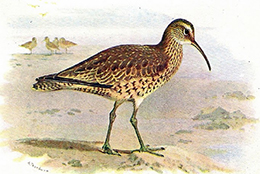About
The Eskimo Curlew was once very abundant and numbered in the hundreds of thousands.
Overhunting and habitat loss have been main reasons for the species decline and have left the species as presumed extinct. Habitat degradation and extinction of important prey species, like the Rocky Mountain locust put further pressure on an already decimated population. The low reproductive rate of the species has hampered the recovery of species numbers. The Eskimo Curlew breeds in Canada, but it winters in South America. And they are one of eight species of curlew; members of the Numenius genus. Unfortunately, there has been no evidence of Eskimo Curlew nests for almost 140 years and an individual has not been officially recorded since 1963.
- Order: Charadriiformes
- Family: Scolopacidae
- Population: <50
- Trend: unknown
- Size: 32-37 cm
- Weight: 270-454g
EDGE Score
Distribution
Their breeding grounds are in Canada, but the species migrates south across the Caribbean to Argentina.
Habitat and Ecology
Their breeding sites are usually found in areas of upland tundra and grassy meadows. Along the autumn migratory route the birds stop in a variety of habitats, but preferentially in areas of crowberry, a core component of their diet, along with blueberries, flies, fly larvae, grasshoppers and beetles. During the spring migration the species rests in mixed-grass prairies, tall grasslands and cultivated areas near water. The Eskimo Curlew winters in the pampas of Argentina, preferring the grasslands with seasonal or permanent wetlands.
